The Self-Directed Learning model was designed to give young people agency over their learning, guiding them to flourish and find a calling that will transform our world. The model embraces highly personalized, hands-on learning with real-world work in service of supporting young people to become curious, independent thinkers with a lifelong love of learning. Learners develop a wide range of skills that underpin self-direction—learning to learn, learning to be, learning to do, and learning to live together. The model centers around five key experiences, which are largely learner-led. Under the model, learners engage in Socratic discussions, challenge their peers to set rigorous daily goals, work on traditional academic disciplines at their own pace, practice self-governance, and tackle real problems through Quests.
Five schools have adopted the Self-Directed Learning model, and over 80 partners have gone through The Forest School and the Self-Directed Learning Institute’s workshops or trainings to design and build their own models. The Forest School and the Self-Directed Learning Institute offer 1:1 coaching and consulting, professional development, cohort learning communities, and resource toolkits to schools interested in implementing their approach.
What Makes This Model Innovative?
Active Self-Direction
Relevance
Customization
Goals
The Self-Directed Learning model seeks to cultivate curious and independent thinkers with a deep, lifelong love of learning.
Learn to Be
Reflecting deeply on identity and purpose while cultivating strong character.
Learn to Learn
Developing strategies to learn any content, skill, or craft.
Learn To Do
Becoming a creator and maker with marketable skills.
Learn To Live Together
Growing in the ability to live with others across lines of difference.
Experience
The Self-Directed Learning model facilitates hands-on, self-directed learning and real-world problem solving. The model requires that learners shoulder the responsibility for learning in ways that grow their curiosity, independence, and love of learning.
The overall student experience is made up of five main components: Socratic Launches, Running Partners, Core Skills, Contracts and Town Halls, and Quests. These components tap into learner interests, are deeply personalized and learner-led, and encourage learners to leverage support from others as they embark on their learning journey.
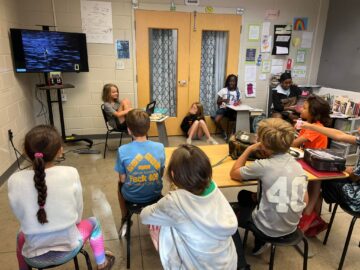 Every morning, learners engage in 15-minute Socratic discussions, called Launches. Launches begin with guides (The Forest School’s version of teachers) or learners telling a thought-provoking story and then asking 3–5 questions with no ‘clear right or wrong’ answer to their studio. Learners then share their opinions and build on the ideas presented by others, engaging in lively debate and discussion. Launches end with an inspiring message, something learners can take with them throughout their day, week, and beyond.
Every morning, learners engage in 15-minute Socratic discussions, called Launches. Launches begin with guides (The Forest School’s version of teachers) or learners telling a thought-provoking story and then asking 3–5 questions with no ‘clear right or wrong’ answer to their studio. Learners then share their opinions and build on the ideas presented by others, engaging in lively debate and discussion. Launches end with an inspiring message, something learners can take with them throughout their day, week, and beyond.
Through Launches, learners learn how to navigate uncertainties and complexity in a safe environment, building critical thinking skills and cross-cultural awareness. They are intentionally designed to get learners thinking at the start of the day and building essential skills needed for lifelong learning. Socratic Launches: Behind the Scenes A Brief Checklist for Designing Socratic Launches
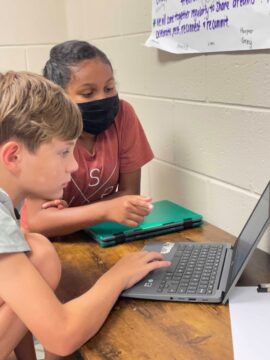 Each learner is assigned a Running Partner or Housemates (a group of 4 learners), who help them set rigorous goals, improve their work, and overcome challenges. Each morning, learners meet with their running partner to set “right-sized” goals. Throughout the day, learners can turn to their running partner for support and mentorship. Running partners help learners focus on what’s important, overcome procrastination, monitor progress, and build their capacity to set and achieve meaningful goals. They also provide actionable feedback and hold their peers accountable to high-quality work, further building learner agency and ownership over learning. Running Partners: Behind the Scenes
Each learner is assigned a Running Partner or Housemates (a group of 4 learners), who help them set rigorous goals, improve their work, and overcome challenges. Each morning, learners meet with their running partner to set “right-sized” goals. Throughout the day, learners can turn to their running partner for support and mentorship. Running partners help learners focus on what’s important, overcome procrastination, monitor progress, and build their capacity to set and achieve meaningful goals. They also provide actionable feedback and hold their peers accountable to high-quality work, further building learner agency and ownership over learning. Running Partners: Behind the Scenes
Core Skills is a time during the day where learners work on traditional academic subjects (e.g., math, science, social studies) at their own pace. During this 90-minute work block, learners have the freedom to make decisions that best support their individualized learning. Learners practice basic goal setting and complete challenges at their own pace to earn learning “badges.” Learners are free to move around the space, work where they are most comfortable, manage their time as they see fit, take breaks, and offer or seek help from their peers or Guides.
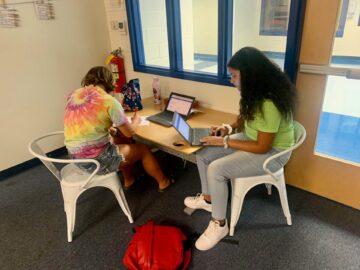 During Core Skills, learners need access to:
During Core Skills, learners need access to:
- the Internet;
- a network of peers and mentors;
- a Guide who helps monitor mastery of content and skills; and
- gamified, responsive, and adaptive e-learning platforms.
The Forest School’s Self-Directed Learning model puts systems and practices in place to ensure learners take ownership of their learning and learning environment. The model uses Contracts and Town Halls to encourage accountability and ownership, providing learners the opportunity to practice self-governance.
Contracts: Contracts are designed to give learners practice developing a structure that respects and works for all learners. At the beginning of the year, learners collaboratively develop community agreements that will govern their learning environment. During the drafting phase, learners are asked to think critically about how they want to be treated and how they will treat others in alignment with the goals of the model: Learning to Be, Learning to Learn, Learning to Do, and Learning to Live Together. Learners then sign the contract, agreeing to this set of guidelines.Throughout the year, learners have the opportunity to make revisions to the contract in response to what is working and what is not. Contracts: Behind the Scenes
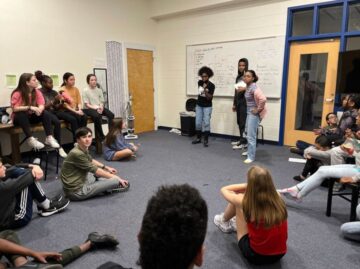 Town Halls: Town Halls are an opportunity for learners and Guides to get together as a group to discuss goals, progress, any challenges facing the studio, and possible solutions to those challenges. While Town Halls are not mandatory, this is a time for learners to share announcements; elect a learner-led group called Council that holds their peers accountable, calls out injustices, facilitates conflict resolution, and ensures everything in the studio is running smoothly; as well as propose and discuss system changes to their studio. Town Halls typically occur at the end of the week and are an opportunity for learners to exercise their voice on how their studio functions. Town Halls: Behind The Scenes
Town Halls: Town Halls are an opportunity for learners and Guides to get together as a group to discuss goals, progress, any challenges facing the studio, and possible solutions to those challenges. While Town Halls are not mandatory, this is a time for learners to share announcements; elect a learner-led group called Council that holds their peers accountable, calls out injustices, facilitates conflict resolution, and ensures everything in the studio is running smoothly; as well as propose and discuss system changes to their studio. Town Halls typically occur at the end of the week and are an opportunity for learners to exercise their voice on how their studio functions. Town Halls: Behind The Scenes
 Quests, or real-world projects that last four- to six-weeks, are a key driver of learning in the Self-Directed Learning model. Quests are opportunities for learners to master 21st-century skills while tackling real problems in authentic contexts. Through a series of challenges, learners develop skills that underpin self-direction while simultaneously exploring traditional topics in science, social studies, history, and more. Learners spend approximately 2–2.5 hours on Quests, three times per week. Quests – Signature Learning Experience
Quests, or real-world projects that last four- to six-weeks, are a key driver of learning in the Self-Directed Learning model. Quests are opportunities for learners to master 21st-century skills while tackling real problems in authentic contexts. Through a series of challenges, learners develop skills that underpin self-direction while simultaneously exploring traditional topics in science, social studies, history, and more. Learners spend approximately 2–2.5 hours on Quests, three times per week. Quests – Signature Learning Experience
There are six key ingredients of a successful Quest: Ingredients of a Successful Quest
- Exhibition: Exhibitions are learner-led and are a time for learners to demonstrate what they have learned in their Quests. This is an opportunity for learners to put their work in front of an authentic audience and get feedback from industry experts, parents, and other guests. Exhibitions – Signature Learning Experience
- Real-World Skills: Quests are intentionally designed to build real-world skills. During the Exhibition, learners utilize these skills in a simulation, showcasing the breadth of skills they have strengthened and acquired.
- Narrative and motivation: Learners have the opportunity to solve problems they care about and find compelling. Quests are designed to be high-interest and vary from session to session. Past Quests have included a Detective Science Quest, where the Spark Studio (ages 5–7) explored and built different systems in the human body; a Bridge Building Quest, where the Elementary Studio (ages 8–10) designed a bridge that connected the Trilith Studios to the neighborhood; and a Golf Cart Quest, where the Middle and High School Studios (ages 11–18) created proposals for a multi-use trail system. Detective Science Quest (spark), Bridge Building Quest (elementary), Golf Cart Quest (middle and high school) The Making of a Politician Quest (whole school) Theater Quest (whole school)
- Real-World Measurement: All Quests should measure and track outcomes in ways that most closely mirror the real world. For example, at the “Bridge Building Quest” Exhibition, learners presented their bridge design to Trilith staff and evaluated their designs much like structural engineers would. Criteria including structural integrity, cost effectiveness, design representative of the Trilith brand, and creativity was used to determine the winner.
- Expert Valuation: High-performing professionals and experts are invited to offer real-world feedback to learners on the solutions they are developing during Quests. These experts are seen as an additional resource for learners to have real-world experiences. These mentor experts often ask questions (e.g., How feasible is this solution in the real world? How compelling is it? How sustainable?) to push learners’ thinking and creative problem solving. External Experts: Behind the Scenes
- Learner-Led: During challenges, learners take the driver’s seat. Learners are empowered to navigate challenges and solve problems autonomously.
Perhaps the most important part of the Quest is the final day, known as Reflection Day. Reflection Day is a time for learners to reflect on the feedback they received on their work and perform an after-action review: 1) What did we set out to do? 2) What actually happened? 3) Is there a difference between what we intended to do and what happened? 4) What can we do differently next time to ensure better results? Reflection Day – Signature Learning Experience
Progress on Quests is measured in a variety of ways, including points for challenges earned, badges for finishing Quests, exhibitions of learner work, feedback provided by users/external experts, and portfolios to showcase work learners are particularly proud of.
Supporting Structures
The Self-Directed Learning model ensures that young people are active drivers of their learning. This model can be integrated into any school’s design but will require key shifts in curriculum and instruction, school culture, adult roles, use of time, community partnerships, space and facilities, and technology.
Learning must be hands-on, learner-led, and structured around real-world problem solving.
In order to implement the Self-Directed Learning model, schools should be prepared to revise their approach to curriculum, instruction, and assessment to facilitate highly personalized, learner-driven learning. All approaches should put learners in the driver’s seat, requiring that they directly grapple with concepts while receiving adult and peer guidance and support.
Schools should be prepared to make the following shifts:
- Curriculum: Intentionally design curricula to facilitate self-directed learning where young people are deeply immersed in real-world work with real-world measurement. Curricula should support personalized learning pathways, be cross-curricular, tap into learners’ curiosities and interests, and allow learners to engage in real-world work via projects. The model works best when the curriculum is robust and flexible.
- Instruction: Implement an instructional approach that consistently emphasizes questioning and discussion, pushing learners to think and approach their thinking from different angles. Instruction should provide opportunities for learners to voice their opinions, share their expertise, problem solve, goal set and reflect, and seek support from others as needed.
- Assessment: Embrace assessment practices that allow learners to demonstrate mastery through a variety of modes including exhibitions or portfolios, progress on digital platforms, feedback processes, etc. Craft experiences and tools that allow learners to set goals, track their own progress, get feedback, and reflect on next steps as they self-direct their learning in meaningful ways.
The Self-Directed Learning model relies on a relationship-rich culture of trust and accountability.
The Self-Directed Learning model is enabled by a culture where young people are trusted to take ownership of their learning and are held accountable for their goals and actions. Sites implementing the model should work toward cultivating a culture where young people are empowered to make decisions that best support their personalized learning journey and to have a say in the look and feel of their learning environment. Warm, trusting relationships, in particular, help create a safe environment for learners to test out ideas, seek help, navigate complexity, and enact their agency in powerful ways. Learners are positioned and encouraged to support each other by providing high-quality feedback, helping monitor progress, and building each other’s capacity to achieve rigorous goals.
Adults must play the role of “gamemakers” who cultivate a learner-driven community and facilitate learner growth.
Under the model, adults play a fundamentally different role from that of traditional teachers. Guides do not lecture; rather, they set up learning environments, experiences, and parameters that inspire young people to take on challenges and self-direct their learning. Guides support learners to navigate the learning process, their own choices, and problem-solving through prompting self-reflection and asking questions. They are seen as “gamemakers” as they make conscious decisions with regards to their practice, so that learners themselves shoulder the responsibility for learning.
Schedules should accommodate deep, self-directed work as well as hands-on learning.
While there is not a prescribed schedule implementing sites must follow, The Forest School encourages implementing sites to create schedules where learners have the freedom to decide how to use their time in order to best support their individualized learning. At the Forest School, this looks like:
- Fixed schedules with embedded flexibility and choice: Learners should be able to make choices among the broad offerings, work at their own pace, take breaks as needed, manage their time as they see fit, and more.
- Extended blocks of work time: Extended work blocks (typically 90+ minutes) allow learners to dive deeply into core subjects, pursue hands-on quests, and offer and/or seek help from their peers and guides.
- Consistent routines for goal setting and reflection: Each morning, learners should be able to meet with their running partner to set daily goals. Similarly, at the end of the day, learners should have an opportunity to reflect on what they have been able to accomplish with their running partner. Daily Goal Setting: Behind the Scenes
A typical day begins with a 15-minute launch and is followed by an extended work block of 90+ minutes for learners to work on Core Skills. During this time, learners set daily goals, planning out what they are going to accomplish that day in order to make progress on their badge plans. A large block of time in the afternoon is dedicated to quest work. Daily Schedule Town Halls typically occur on Fridays but can be implemented at anytime that works best for the learning community.
Partnerships with local businesses, government, and community organizations should be leveraged to provide learners with meaningful, real-world learning experiences.
Real-world work is an integral part of the Self-Directed Learning model. The Forest School encourages schools to seek out and leverage community expertise to enrich learning. Schools should be prepared to cultivate local partnerships to support real-world measurement and access expert valuation—essential ingredients of Quests. In addition to enriching learning, the goal of these partnerships is to also build learners’ social capital across industries. Experts & Coaches
A school’s physical space must enable independence, ownership, and real-world learning experiences.
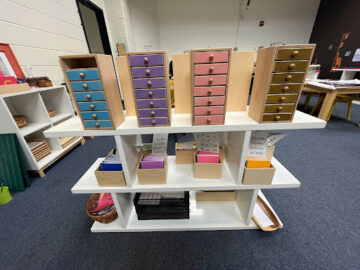 The physical environment plays an important role in how young people can self-direct their learning. Learners should be able to select between different spaces in the classroom (e.g., on the floor or at desks, with others or alone) to work. The setup of the learning space should allow learners to independently access materials needed to do their work as well as enable them to get started on their own, work at their own pace, and return to work as needed. Learning should extend beyond the classroom, giving learned access to meaningful work, industry professionals, and more.
The physical environment plays an important role in how young people can self-direct their learning. Learners should be able to select between different spaces in the classroom (e.g., on the floor or at desks, with others or alone) to work. The setup of the learning space should allow learners to independently access materials needed to do their work as well as enable them to get started on their own, work at their own pace, and return to work as needed. Learning should extend beyond the classroom, giving learned access to meaningful work, industry professionals, and more.
The model works best when schools use powerful educational technology to support self-paced learning as well as adult and peer feedback.
Learners should have access to the internet and gamified, responsive, and adaptive e-learning platforms. The variety of digital platforms used should meet different learners’ needs and allow learners to work at their own pace.
While monitoring goal progress and mastery can certainly happen in low-tech ways, the Forest School leverages Journey Tracker, an online dashboard used to set goals and track progress on their goals and Badge Plans. Journey Tracker also makes learners’ work public and allows for work to be peer reviewed. Journey Tracker: Behind the Scenes
Learning must be hands-on, learner-led, and structured around real-world problem solving.
In order to implement the Self-Directed Learning model, schools should be prepared to revise their approach to curriculum, instruction, and assessment to facilitate highly personalized, learner-driven learning. All approaches should put learners in the driver’s seat, requiring that they directly grapple with concepts while receiving adult and peer guidance and support.
Schools should be prepared to make the following shifts:
- Curriculum: Intentionally design curricula to facilitate self-directed learning where young people are deeply immersed in real-world work with real-world measurement. Curricula should support personalized learning pathways, be cross-curricular, tap into learners’ curiosities and interests, and allow learners to engage in real-world work via projects. The model works best when the curriculum is robust and flexible.
- Instruction: Implement an instructional approach that consistently emphasizes questioning and discussion, pushing learners to think and approach their thinking from different angles. Instruction should provide opportunities for learners to voice their opinions, share their expertise, problem solve, goal set and reflect, and seek support from others as needed.
- Assessment: Embrace assessment practices that allow learners to demonstrate mastery through a variety of modes including exhibitions or portfolios, progress on digital platforms, feedback processes, etc. Craft experiences and tools that allow learners to set goals, track their own progress, get feedback, and reflect on next steps as they self-direct their learning in meaningful ways.
The Self-Directed Learning model relies on a relationship-rich culture of trust and accountability.
The Self-Directed Learning model is enabled by a culture where young people are trusted to take ownership of their learning and are held accountable for their goals and actions. Sites implementing the model should work toward cultivating a culture where young people are empowered to make decisions that best support their personalized learning journey and to have a say in the look and feel of their learning environment. Warm, trusting relationships, in particular, help create a safe environment for learners to test out ideas, seek help, navigate complexity, and enact their agency in powerful ways. Learners are positioned and encouraged to support each other by providing high-quality feedback, helping monitor progress, and building each other’s capacity to achieve rigorous goals.
Adults must play the role of “gamemakers” who cultivate a learner-driven community and facilitate learner growth.
Under the model, adults play a fundamentally different role from that of traditional teachers. Guides do not lecture; rather, they set up learning environments, experiences, and parameters that inspire young people to take on challenges and self-direct their learning. Guides support learners to navigate the learning process, their own choices, and problem-solving through prompting self-reflection and asking questions. They are seen as “gamemakers” as they make conscious decisions with regards to their practice, so that learners themselves shoulder the responsibility for learning.
Schedules should accommodate deep, self-directed work as well as hands-on learning.
While there is not a prescribed schedule implementing sites must follow, The Forest School encourages implementing sites to create schedules where learners have the freedom to decide how to use their time in order to best support their individualized learning. At the Forest School, this looks like:
- Fixed schedules with embedded flexibility and choice: Learners should be able to make choices among the broad offerings, work at their own pace, take breaks as needed, manage their time as they see fit, and more.
- Extended blocks of work time: Extended work blocks (typically 90+ minutes) allow learners to dive deeply into core subjects, pursue hands-on quests, and offer and/or seek help from their peers and guides.
- Consistent routines for goal setting and reflection: Each morning, learners should be able to meet with their running partner to set daily goals. Similarly, at the end of the day, learners should have an opportunity to reflect on what they have been able to accomplish with their running partner. Daily Goal Setting: Behind the Scenes
A typical day begins with a 15-minute launch and is followed by an extended work block of 90+ minutes for learners to work on Core Skills. During this time, learners set daily goals, planning out what they are going to accomplish that day in order to make progress on their badge plans. A large block of time in the afternoon is dedicated to quest work. Daily Schedule Town Halls typically occur on Fridays but can be implemented at anytime that works best for the learning community.
Partnerships with local businesses, government, and community organizations should be leveraged to provide learners with meaningful, real-world learning experiences.
Real-world work is an integral part of the Self-Directed Learning model. The Forest School encourages schools to seek out and leverage community expertise to enrich learning. Schools should be prepared to cultivate local partnerships to support real-world measurement and access expert valuation—essential ingredients of Quests. In addition to enriching learning, the goal of these partnerships is to also build learners’ social capital across industries. Experts & Coaches
A school’s physical space must enable independence, ownership, and real-world learning experiences.
 The physical environment plays an important role in how young people can self-direct their learning. Learners should be able to select between different spaces in the classroom (e.g., on the floor or at desks, with others or alone) to work. The setup of the learning space should allow learners to independently access materials needed to do their work as well as enable them to get started on their own, work at their own pace, and return to work as needed. Learning should extend beyond the classroom, giving learned access to meaningful work, industry professionals, and more.
The physical environment plays an important role in how young people can self-direct their learning. Learners should be able to select between different spaces in the classroom (e.g., on the floor or at desks, with others or alone) to work. The setup of the learning space should allow learners to independently access materials needed to do their work as well as enable them to get started on their own, work at their own pace, and return to work as needed. Learning should extend beyond the classroom, giving learned access to meaningful work, industry professionals, and more.
The model works best when schools use powerful educational technology to support self-paced learning as well as adult and peer feedback.
Learners should have access to the internet and gamified, responsive, and adaptive e-learning platforms. The variety of digital platforms used should meet different learners’ needs and allow learners to work at their own pace.
While monitoring goal progress and mastery can certainly happen in low-tech ways, the Forest School leverages Journey Tracker, an online dashboard used to set goals and track progress on their goals and Badge Plans. Journey Tracker also makes learners’ work public and allows for work to be peer reviewed. Journey Tracker: Behind the Scenes
Supports Offered
The Forest School and the Institute for Self-Directed Learning offer the following supports to help you implement their approach. Services
School Design Blueprint
Cost Associated
The Forest School’s high school blueprint is available for purchase. What it includes: case for change, mission, graduate profile, design principles, design constraints, key beliefs about learning and motivation, target population, signature learning experiences (detailed), college profile, and more.
Light-Touch Advisory
Cost Associated
The Institute for Self-Directed Learning works with education leaders in an advisory capacity who are seeking to promote self-directed learning in their learning environments.
Project-Based Consulting
Cost Associated
For larger projects, the Institute for Self-Directed Learning offers deep-dive, project-based consulting. This offering provides more in-depth coaching and support around designing self-directed learning environments.
Workshops and Webinars
Cost Associated
The Institute for Self-Directed Learning offers a host of workshops and webinars for education leaders and teachers seeking to build a blueprint for a new self-directed learning model. Sessions center on how to build a blueprint, how to bring a self-directed learning model to life, and how to create pathways for equity and innovation.
Leading Schools
Cost Associated, Funding Available
The Institute for Self-Directed Learning offers a virtual two-year cohort program for forward-thinking leaders seeking to design and launch a transformative, learner-led school. Through collaborative Zoom calls, this cohort tackles issues including equitable school design, creating a blueprint for a learning model that empowers young people, resources critical for leading schools, and more.
Limited scholarships are available.
The Forest School’s high school blueprint is also available for purchase.
Reach
Impact
The Forest School’s Self-Directed Learning model has had a positive impact on learners’ college and career readiness, academic growth, and overall satisfaction with their learning experience. Below are just a few examples of this impact on learners and parents:
College and Career Readiness
- From 2020 to 2022, 65% of returning middle schoolers improved their total scores on the College and Career Readiness Assessment Plus (CCRA+).
- 86% of high schoolers—whether they’ve been at The Forest School 2 or 3 years—improved their total scores.
- 38% of high schoolers improved their mastery level—a significant achievement. There are five mastery levels for CCRA+: Below Basic, Basic, Proficient, Accomplished, and Advanced.
Math and ELA proficiency
- On average, learners at The Forest School scored ahead of grade level in the core subjects of math and ELA on the Iowa Test of Basic Skills. The Forest School learners show tremendous growth from scoring three months behind grade level in 2nd grade, to two months ahead of grade level in 3rd grade, and by high school they are 2 to 3+ years ahead of grade level.
Learner and Parent Satisfaction
- On average, learners rate their overall satisfaction with the learning experience 4.8/5 stars.
- On average, parents rate their overall satisfaction with their learner’s experience 4.85/5 stars.




